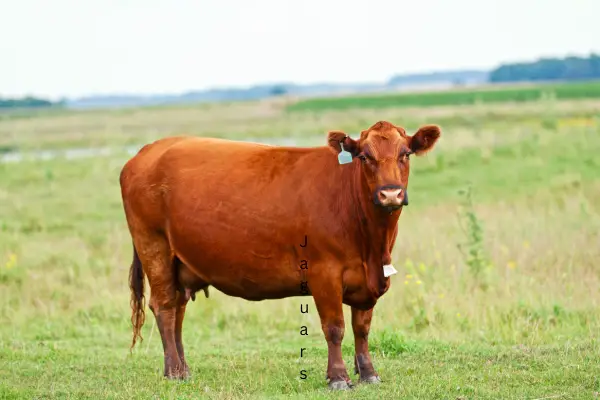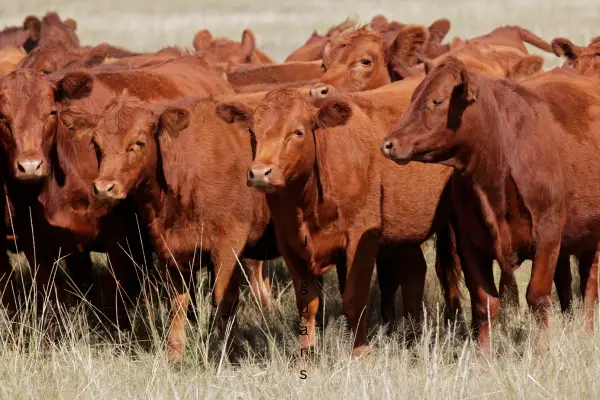The Red Angus is a beef cattle breed known for its vibrant red coat, good temperament, and hardy nature that allows it to thrive in a variety of environments. In this blog post, we will cover the origin, appearance, temperament, common uses, and advantages of the Red Angus breed.
History of Red Angus Cattle
The Red Angus breed has its origins in Aberdeen Angus cattle imported from Scotland to North America in the 19th century. These black Angus cattle were crossed with native red Shorthorn cattle, resulting in a new red polled breed that became known as Red Angus.
The first Red Angus herd book was published in 1953 by cattle breeders looking to conserve the red coat color pattern. Since then, the breed has grown substantially across Canada and the United States.
Some of the ancestral bloodlines that contributed to the original Red Angus cattle in North America include the Black Angus, Shorthorn, and Galloway breeds. These foundation cattle influenced traits like high fertility, maternal instinct, muscle tone, and ruggedness seen in modern Red Angus.
Physical Attributes and Markings
The most distinctive physical attribute of Red Angus cattle is their solid red hair coat. Within the breed, colors can range from light red to dark red. Occasionally, Red Angus cattle may have some white markings on the tail, udder, or feet. Black points on the ears, muzzle, tail and teats are also common.
Red Angus cattle have a very smooth, muscular appearance with a broad, straight back. Their necks blend smoothly into well-rounded shoulders. On average, mature Red Angus cows weigh around 1,200 to 1,500 pounds, while mature Red Angus bulls range from about 1,800 to 2,200 pounds or more.
The face of a Red Angus is clean of non-muscular tissue and the breed has a broad muzzle with wide-set eyes and nostrils. Both males and females are naturally polled, meaning they do not grow horns.

Temperament and Disposition
Red Angus are known for having an easy going temperament and calmer disposition compared to some other beef cattle breeds. They exhibit strong maternal instincts and readily protect their offspring if they sense a threat, but are otherwise docile by nature.
Their tolerant temperament enables ranchers and stockmen to easily handle groups of Red Angus for tasks like moving cattle, branding, separating calves, or loading for transportation. The mellow nature of this breed also reduces injuries due to cattle activity.
Cattle Uses and Products
Red Angus cattle are a dual-purpose beef breed raised for both their high quality meat as well as value as breeding stock. Certain bloodlines are specialized as either maternal or paternal lines:
Maternal Lines:
– Selected for excellent maternal traits like calving ease, mothering instinct, milk production
– Often used as breeding heifers for producing crossbred calves
Paternal Lines:
– Selected for enhanced growth efficiency, muscle building ability, and carcass merit
– Used as herd sires for siring fast-growing, thick-muscled calves
On the meat side, Red Angus is appreciated for its fine marbling qualities and richer beef flavor. When handled under low-stress conditions prior to harvesting, Red Angus produces exceptionally tender beef.
When used in a systematic crossbreeding program, hybrid Red Angus calves exhibit strong hybrid vigor in traits like fertility, survival, growth rate, and calf weaning weights.
Red Angus Compared to Black Angus
The Red Angus and its close relative, the Black Angus, share many comparable traits but also differ in a few aspects that can impact beef producers:
- Calving Ease – Red Angus achieve higher calving ease scores thanks to calves being born smaller
- Maternal Ability – Higher milk production in Red Angus females
- Disposition – Slightly calmer temperaments in Red Angus cattle
- Marbling & Carcass – Black Angus excel in marbling qualities and yield grade
- Heat Tolerance – Dark-hided Black Angus are less heat tolerant
- Hybrid Vigor – Red coat color enables optimal crossbreeding advantages
When selecting between Red or Black Angus bulls or heifers, ranchers must consider their production environment and breeding goals. Both quality heritage beef breeds can significantly improve herd performance under the right conditions.
Crossbreeding and Hybrid Vigor
A major advantage of Red Angus cattle for commercial beef operations is their use as a terminal crossbreeding sire line. The Red Angus breed offers the bonus of a red coat color pattern, allowing easy visual indication of crossbred offspring compared to the solid black of many Angus crosses.
Crossbreeding takes advantage of heterosis, also known as hybrid vigor or outbreeding enhancement. With a greater genetic difference between parent lines, the resulting offspring often show substantial improvements in traits like fertility, survival, growth rates, feed efficiency, calf weaning weights, and overall performance.
Using Red Angus bulls on dams from continental breeds or British-cross cows capitalizes on an optimal genetic distance to achieve maximum hybrid vigor in feeder calves. The bonus heterosis gives crossbred calves an added edge for efficient growth and gaining profit when those calves are eventually sold and harvested.
Ideal Environments and Conditions
Red Angus were bred to perform well in harsh landscapes and challenging environments. Compared to traditional Black Angus, the Red Angus thrives under hot and humid conditions. Their hair coat seems to offer an advantage against heat stress and insect pests.
This breed is right at home on open grasslands, pasture, and rangelands. As easy-keeping foragers, Red Angus cattle do well on poorer quality roughage. The Red Angus frame size lends itself perfectly to foraging capabilities. Due to their highly fertile nature, Red Angus cattle work efficiently on expansive grazing lands where calving is done out on pasture.
Availability of Breeding Stock
The Red Angus breed has expanded substantially since that first herd book in 1953. Today it is estimated that Red Angus make up about 5% of American cattle populations. Red Angus genetics can be sourced across most cattle-producing regions.
Yet compared to the ubiquitous Black Angus, availability of quality Registered Red Angus breeding stock is still more restricted. Cattle producers may need to engage in additional planning and preparation to locate and secure top-tier Red Angus bulls, cows, or heifers to advance their breeding program goals.
Conclusion
Ranchers looking to add genetic diversity, hybrid vigor, improved calving ease, heat adaptability, and docile dispositions will find the Red Angus checks many boxes. While slightly less available than Black Angus, this heritage breed offers numerous valuable traits that can enhance overall herd productivity and profitability.


